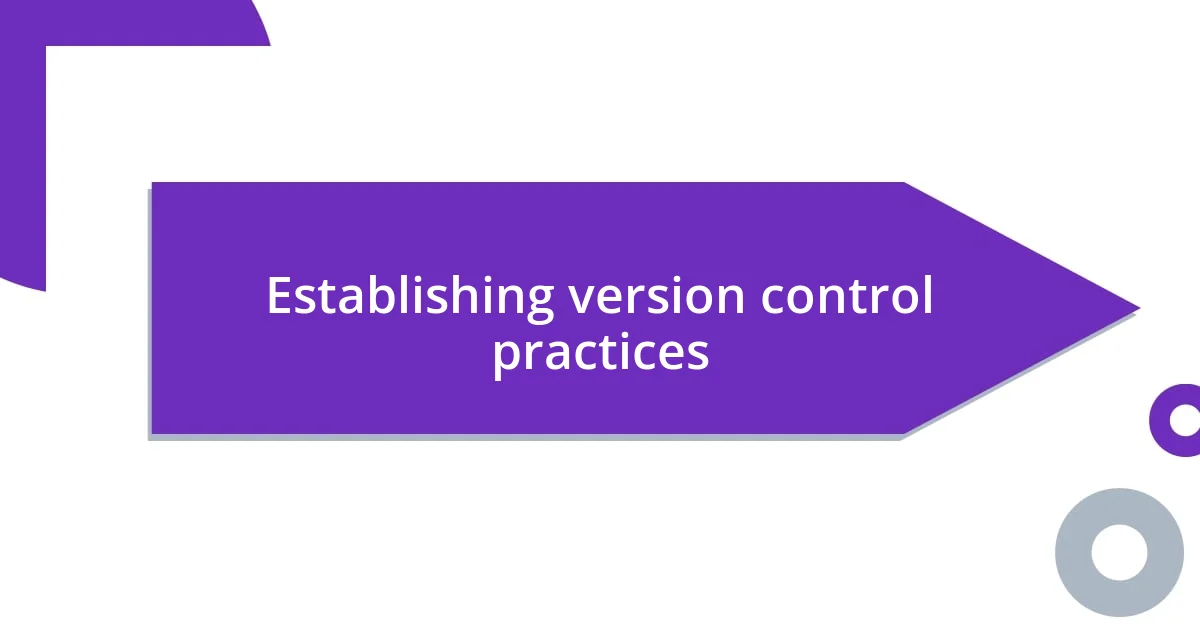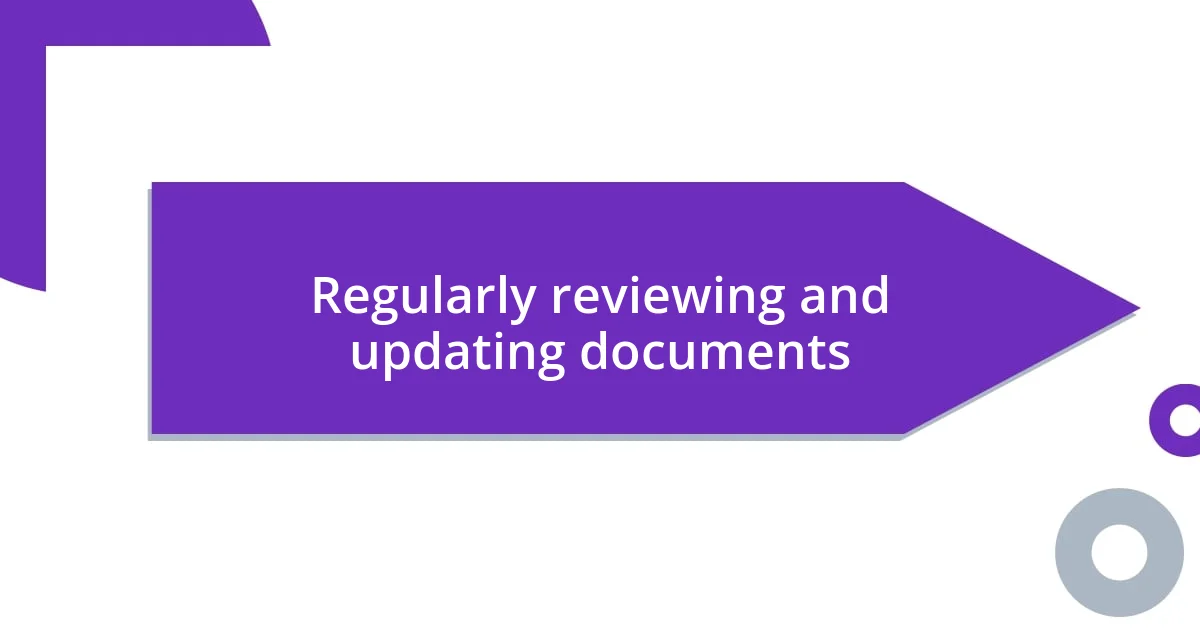Key takeaways:
- Implementing a structured categorization system and regular document reviews significantly enhance workflow and reduce clutter.
- Utilizing digital tools and standardized naming conventions streamlines document organization, making files more accessible and easier to find.
- Establishing clear version control practices and integrating communication tools improves collaboration and reduces misunderstandings among team members.

Understanding document management strategies
When I first dove into document management, I was amazed at how many strategies existed, each offering unique benefits. I often found myself pondering, which method would truly streamline my workflow? Understanding the nuances of each strategy can make a significant difference in your efficiency and organizational abilities.
Let’s talk about categorization, a fundamental strategy that I’ve found indispensable. I remember a time when my digital files were a chaotic ocean of documents. By implementing a structured folder system based on project types and deadlines, not only did my anxiety decrease, but I now tackle tasks with more clarity. It’s funny how a little organization can turn a daunting task into a breeze!
Another key strategy I’ve learned is the importance of regular reviews. At one point, I neglected this step, thinking everything was in its place. Then, I discovered outdated documents cluttering my workspace. Now, I set aside time each month to prune my files. I can’t tell you how much relief it brings—knowing everything I have is relevant and easy to find. What strategies have you found helpful in creating order out of chaos? I’d love to hear your thoughts!

Identifying your document management needs
Identifying your document management needs starts with a clear understanding of your workflow. I remember a time when I had too many files and not enough clarity about their purpose. It was overwhelming! By taking a step back and assessing which documents were crucial for my daily tasks, I was able to prioritize my needs effectively. This reflection helped me focus on what truly matters.
Consider these points when evaluating your document management needs:
- Assess the volume of documents you handle regularly.
- Identify specific types of documents that require special attention (like contracts or client communications).
- Determine how often you need to access certain documents.
- Evaluate the tools and resources you currently use for document management.
- Think about potential growth: will your needs change in the next few years?
Each of these aspects plays a vital role in crafting a solution tailored to your unique requirements.

Implementing effective organization systems
Implementing effective organization systems is essential for smooth document management. One of the best decisions I made was to adapt to a digital tool that suits my workflow. Initially, I hesitated, fearing a steep learning curve, but my investment in software that allows me to tag and categorize documents transformed my process. With everything searchable at my fingertips, I rarely find myself lost in a maze of files anymore.
Another effective approach I discovered is creating a standardized naming convention. I recall countless hours spent searching through files that had cryptic names or no designation at all! By using a clear naming format that includes dates and project identifiers, not only have I saved time, but I’ve also minimized frustration. It’s rewarding to see everything come together seamlessly; it’s like finding a long-lost item that was right in front of you!
Incorporating removable labels and color coding systems has also proven beneficial. I once managed a team project where confusion reigned supreme—each member had their own filing style. By introducing color codes that represented progress stages, we all quickly came to adapt to a universal language, enhancing collaboration and transparency. It’s amazing how a bit of color can brighten up even the dullest organizational task!
| Organization System | Benefits |
|---|---|
| Digital Tools | Enhanced accessibility and searchability |
| Naming Convention | Reduced search time and confusion |
| Color Coding | Improved team collaboration and clarity |

Establishing version control practices
Establishing version control practices is a game changer for anyone dealing with multiple document revisions. I still remember the chaos of collaborating on a report where each team member had their own version floating around. It felt like a never-ending treasure hunt, trying to figure out which was the latest or most accurate version. By implementing a strict versioning system—like denoting changes in the filename with simple numbers or dates—I transformed that frustration into clarity and confidence.
Have you ever sent out a document, only to be bombarded with edits and changes right afterward? I certainly have! That’s why I began using a centralized document management platform that not only tracks changes but also allows for comments and suggestions. Each time someone made a modification, I received an automatic notification. This approach kept everyone in the loop, significantly reducing the back-and-forth that usually causes misunderstandings.
Furthermore, I realized the importance of communication in version control. I once worked on a presentation where I assumed everyone was on the same page, only to find out later that some hadn’t seen the latest updates. Now, I always follow up with a quick summary after major revisions, which has remarkably improved our collaboration. Are you proactively sharing version updates in your projects? It not only ensures everyone is aligned but also fosters a transparent and accountable working environment.

Streamlining document sharing processes
Sharing documents effectively can often feel like navigating a labyrinth. When I first started collaborating on remote projects, I struggled with sending files back and forth via email. I decided to switch to a cloud-based platform that allowed real-time access. It felt liberating knowing all team members could view and edit documents simultaneously, eliminating the anxiety of lost emails and outdated versions. Have you tried a similar approach? The ease of sharing and editing was a true revelation.
In my experience, using shared folders with permissions tailored to team roles can make a huge difference. There was a time I had to juggle different access levels for various team members, and it got confusing fast. By establishing clear permissions—who could view, edit, or comment—I was able to create a sense of trust and openness. It was a relief to see no one felt left out, and it streamlined our collaboration.
I’ve also discovered that integrating messaging tools within document sharing platforms can boost immediate feedback. I recall collaborating on a critical client proposal when a simple chat function allowed us to discuss changes without leaving the document. The instant connection transformed our workflow, making it feel more like a conversation rather than a chore. Have you considered how instant communication can speed up your document sharing? Embracing these small changes has truly revolutionized how I approach document collaboration.

Regularly reviewing and updating documents
Regularly reviewing and updating documents is essential, as I’ve learned from firsthand experience. There was a time when I let reports languish, assuming they were still relevant. Then, I was caught off guard when a client referred to outdated data during our meeting. It hit me how crucial it is to revisit documents regularly, ensuring that what I’m presenting is not just accurate but also current. Have you ever felt that sinking feeling of realizing the information you provided was obsolete?
I’ve found that setting a periodic review schedule not only keeps documents fresh but also enhances overall clarity. In one of my previous roles, I initiated monthly reviews for our project plans. Those brief sessions allowed us to spot discrepancies early on, turning potential miscommunications into streamlined processes. It was satisfying to see how these check-ins transformed our efficiency. Imagine what a difference such proactive measures could make in your workflow.
Ultimately, involving the entire team in this process truly amplifies its effectiveness. I remember organizing a collaborative update session where everyone contributed their insights. It struck me how diverse perspectives can enrich our understanding of the material, shining a light on aspects I might have overlooked. Are you harnessing the collective knowledge of your team to refine your documents? I can assure you that this collaborative spirit not only keeps the documents current but also fosters a sense of ownership and cohesion among team members.












